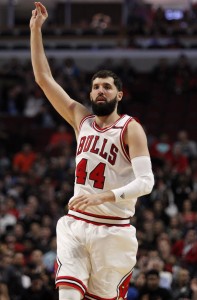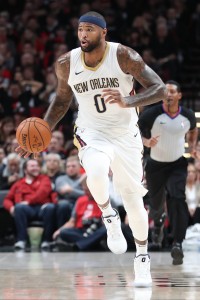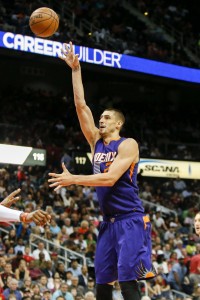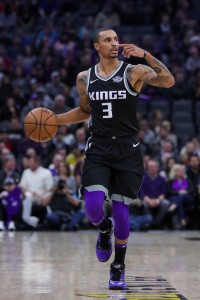The NBA trade deadline is less than two weeks away, and there’s no shortage of players around the league who could change teams. With that in mind, we’re taking a closer look at some of those top trade candidates, breaking them down by division.
While our focus will be primarily on teams expected to be sellers at the deadline, our lists may also include some players on contenders who could be used as trade chips when those teams look to make upgrades.
So far, we’ve covered the Southeast, Southwest, Atlantic, and Northwest. We’re examining the Central Division today, so let’s dive in and identify seven players who could be on the move on or before February 8…
 Nikola Mirotic, PF (Bulls): A potential fit for the Jazz or Pistons, among other teams, Mirotic is a player whose trade potential we’ve discussed at length over the last couple months, so we won’t spend long revisiting it. Still, it’s worth reiterating what a terrific job Mirotic has done of boosting his own value this season — his 17.0 PPG, .475 FG%, .429 3PT%, and 6.5 RPG all blow away his previous career highs, albeit in a small sample (23 games). If he can continue playing anywhere close to that level, he’ll be a strong value at $12.5MM next season, and may even net the Bulls the first-round pick they’re reportedly seeking.
Nikola Mirotic, PF (Bulls): A potential fit for the Jazz or Pistons, among other teams, Mirotic is a player whose trade potential we’ve discussed at length over the last couple months, so we won’t spend long revisiting it. Still, it’s worth reiterating what a terrific job Mirotic has done of boosting his own value this season — his 17.0 PPG, .475 FG%, .429 3PT%, and 6.5 RPG all blow away his previous career highs, albeit in a small sample (23 games). If he can continue playing anywhere close to that level, he’ll be a strong value at $12.5MM next season, and may even net the Bulls the first-round pick they’re reportedly seeking.- Robin Lopez, C (Bulls): Compared to Mirotic, Lopez has flown under the radar this season as a trade candidate, but he finds himself in a pretty similar situation (minus the preseason scrimmage dust-up). The veteran center has a $13.79MM cap hit for this season, followed by one more guaranteed year worth $14.36MM, so he offers a little team control without necessitating a long-term commitment. A solid defender in the middle, Lopez has been his usual productive self this season, averaging a career-high 12.9 PPG with a .536 FG%. If big-name centers like DeAndre Jordan and Hassan Whiteside stay put at the deadline, Lopez would be a decent Plan B or C for a club seeking a frontcourt upgrade.
- Reggie Jackson, PG (Pistons): The Pistons reportedly explored potential Jackson trades last season, then did so again in the offseason. The veteran point guard hasn’t been mentioned in any legit trade rumors since opening night, but he’s still a subject of frequent speculation, since the Pistons are known to be surveying the trade market and Jackson’s contract makes him a logical outgoing piece in any major move. That contract – along with Jackson’s ongoing injury issues – will likely hurt his value until he shows he’s capable of once again being the sort of player he was during his first full season in Detroit (18.8 PPG, 6.2 APG). Nonetheless, there could be teams out there interested in an opportunity to buy low.
- Stanley Johnson, SF (Pistons): The eighth overall pick in the 2015 draft, Johnson has provided solid defense during his three NBA seasons in Detroit, but doesn’t offer much on the other end of the court — for his career, he’s shooting just 36.4% from the floor and 29.7% from outside. Still just 21 years old, Johnson has tantalizing upside and will remain on his rookie contract through 2019. He’s averaging a career-high 27.4 minutes per game for the Pistons this season in 35 contests (23 starts), but the team has reportedly been willing to discuss him in trade talks. Assuming Detroit’s asking price isn’t unreasonable, Johnson should be a prime target for a few rebuilding teams, especially if any of those clubs believe they could improve the young forward’s jump shot.
- Tristan Thompson, C (Cavaliers): The Cavaliers have several players who could be traded before this year’s deadline, and some are more likely to be dealt than Thompson. Channing Frye‘s expiring contract looks like a lock to be used in a trade, and there’s a good chance Iman Shumpert will be on the move as well. Still, those players are essentially just trade chips due to their cap figures — Thompson’s case is a bit more interesting, since he could actually provide multiyear value to a team in need of frontcourt help. Thompson is overpaid, with two years and $36MM left on his contract after this season, but he’s still only 26 years old and has more on-court value than a lot of bigs being paid at a similar rate (think Joakim Noah, Timofey Mozgov, Bismack Biyombo, and Ian Mahinmi). With Thompson playing fewer minutes than ever in Cleveland this season, his trade stock is at an all-time low, meaning the Cavs might even be willing to attach another asset or two in a deal.
- John Henson, C (Bucks): When Greg Monroe headed to Phoenix earlier this season in the Eric Bledsoe deal, the Bucks were probably hoping that second-year big man Thon Maker would take on a more substantial role. Although Maker’s minutes have increased, his production has slipped, and Milwaukee has had to rely more on Henson at center. The 27-year-old has been up to the task, averaging a respectable 8.6 PPG, 6.7 RPG, and 1.5 BPG with a career-best .587 FG%. Still, Henson’s skill-set is somewhat limited — he’s a decent piece off the bench, but he’s probably not the center the Bucks want on the court in crunch time in the playoffs. Henson’s $11.4MM cap hit makes him a candidate to be moved if the Bucks trade for another center, and while he has has two more guaranteed years left on his deal, his declining annual cap hits are at least a little team-friendly.
- Jabari Parker, F (Bucks): A trade package that includes Henson and rookie scale players like D.J. Wilson and Rashad Vaughn is likely the Bucks‘ preference, but if the opportunity to land an impact big man arises and offering Parker is required to get it done, the team will have to seriously consider it. It’s been a long time since Milwaukee had Parker, Giannis Antetokounmpo, and Khris Middleton healthy and in the lineup at the same time, so the chance to get a look at that trio down the stretch this season may be too intriguing for the franchise to pass up. Still, Parker is expected to get much more expensive in a few months when he reaches restricted free agency, and the Bucks already have nearly $106MM on their books for 2018/19. If the team plans to re-sign the former second overall pick, perhaps moving another contract to stay out of the tax, then he’ll stay put at the deadline. But if there are any doubts about Parker’s long-term future in Milwaukee, gauging his value on the trade market makes sense.
Here are a few more potential Central trade candidates to monitor:
- Jerian Grant, PG (Bulls): Grant still has a year and a half left on his rookie contract and the Bulls are reportedly gauging interest in him. Given his modest upside though, Grant is unlikely to bring back a significant return.
- Luke Kennard, SG (Pistons): If the Pistons target a big fish, Kennard may have to be up for discussion. I don’t expect him to be moved though.
- Matthew Dellavedova, G / Mirza Teletovic, PF (Bucks): While Henson is more likely to be the player included in a Bucks trade to make the salaries work, Dellavedova’s and Teletovic’s cap hits ($9.6MM and $10.5MM, respectively) could also be useful. It won’t be easy to move either contract though.
- J.R. Smith, SG (Cavaliers): Smith has been a mess since signing a lucrative four-year contract in the 2016 offseason. Dumping his contract probably isn’t viable at this point for the Cavaliers, but I’m sure they’ll explore it.
- Al Jefferson, F/C (Pacers): Another beneficiary of 2016’s league-wide spending spree, Jefferson is overpaid and underused. However, his $10MM salary for 2018/19 is only partially guaranteed for $4MM — that figure could be reduced further if he’s stretched, so he represents an expiring contract of sorts. The Pacers actually have a few contracts structured this way, but Jefferson is the only player on such a deal who isn’t a key rotation piece.
Photo courtesy of USA Today Sports Images.




